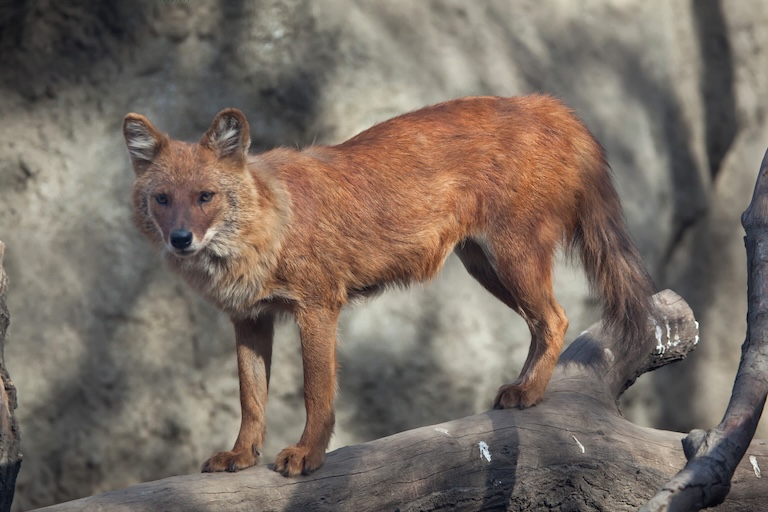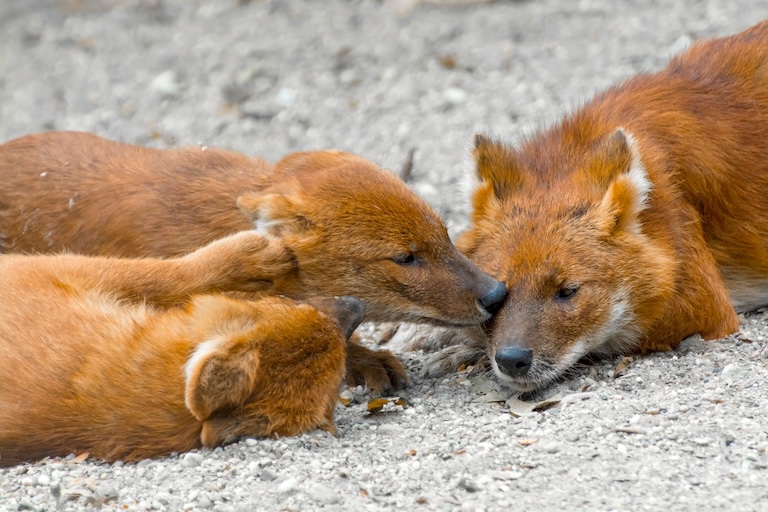Dhole Profile
Dogs are well known for humping anything that will stand still long enough, and according to the genetic research around a strange bastardised canid, they’ve been doing so for millions of years. From one forbidden love affair between two distinct species, came a strange and unusual offspring, the
Dhole: a fox-like dog species from Asia with a very funny name.

Dhole Facts Overview
| Habitat: | Dense forest steppes, and the thick jungles of the plains as well as the hills |
| Location: | South, East and Southeast Asia |
| Lifespan: | 16 years in captivity |
| Size: | 50cm (20 in) tall, 1.4 m (4.6 ft) long |
| Weight: | 21 kg (46 lb) |
| Colour: | Reddish brown |
| Diet: | Medium to large mammals, insects, fruit and vegetables, grasses, leaves |
| Predators: | Leopards |
| Top Speed: | 50 km/h (30 mph) |
| No. of Species: | 1 |
| Conservation Status: | Endangered |
Once you begin to pronounce Dhole as “D-hole” it’s very hard to break the habit. But to give these d-holes their due, these are highly unusual canids from Asia, stemming from a period of hybridisation between African wild dogs and a seemingly unknown Canis species.
And they had been doing fairly well, with a vast range that spanned into Europe, until humans and climate change decimated the large animal populations they preyed on.
Today, these quirky dogs are limited to fragmented populations and are an endangered species. What’s left though, are as smart, social and brutal as any dog you’ll meet.
Interesting Dhole Facts
1. They’re Canids
The Canidae family is the group of Carnivorans that contains (almost) all the doglike animals.
Dogs, being the most dog-like of all, are found here, but so are foxes, jackals, coyotes and wolves, and it’s not all that easy to tell some of them apart. There are dog-like foxes, fox-like dogs, and jackal-like wolves, among others, and the Dhole looks a bit like a mix of all four.
In an attempt to make things a bit simpler, there are three subfamilies of Canid, but to complicate things back up again, two of these are already extinct, so we’re back to square one with what’s left.
Within the remaining subfamily, the Caninae, there are two big branches: the Vulipini and Canini tribes. The Vulpines include all the foxes and, annoyingly, the racoon dogs; the Canini tribe has the rest, so: all the wolves, jackals and those terrible little bug-eyed ankle biters in the park.
Dholes are in this latter tribe, but the convolution doesn’t end here.

There’s a whole clade, or subtribe of weird dogs from South America that are best discussed in their own right, leaving the more wolf-like subtribe of Canina, which contains the two jackal genera, the African wild dogs and the Canis genus. Between these two sits Cuon, a genus with a single species: the Dhole.
All of this is to say that despite its foxy appearance, the Dhole is between a wolf and an African wild dog, and this is important because it describes exactly where it came from. 1
2. They’re Reticulated
Most times, what this means is they’re covered in a net-like pattern, as with the reticulated pythons or giraffes.
But in evolutionary terms, this is a reference to the interlacing lines of its taxonomic tree, and the dhole, with its distinctly pattern-less coat, is the product of reticulated evolution. The ancestry of this species appears to be a result of a hybridisation event between a Canis species and an African wild dog, Lycaon pictus.
Essentially, when a wolf and a wild dog love each other very much, the wolf puts its d-hole into the v-hole of a dog (or the other way around) and then some months later the stork shows up with a completely new and unusual animal.
This explains why they’re so weird looking, but is a rare example of when hybrids are able to exploit a niche in ways neither of the parent species can and end up becoming their own thing – hybrids are often sterile, which counts them out entirely, or they’re fertile but otherwise not as fit as either parent species and don’t make it far.
For the dhole to have made it this far, hybridisation events must have been common enough to make offspring that didn’t breed too closely with one another. There’s evidence that the wild dogs and the dhole were also bumping uglies as recently as the Pleistocene, though their ranges no longer overlap.
3. They were once widespread
There were once several subspecies of dhole, including some in Europe, which were even larger than the modern subspecies. It’s said to have been as big as a wolf, and it wasn’t the only one.
Most of Asia was covered in dholes at one point, though the poor things are gone from almost all of it now.
It’s likely the European populations were involved in the initial interbreeding between the African wild dogs and the Canid species, which then branched across into Asia before people mostly took over.

4. They’re highly social
Being neither Canis nor Lycaon, dholes have their own unique set of traits that build upon ancestral ones. They make unusual whistling calls, like those of foxes, and nobody knows how they do it.
They talk a lot in other ways, too, with screams and chatters and laughing sounds, and all of these contribute to a high level of sociality among dhole communities, but unlike dogs and wolves, they don’t howl or bark.
They have a lower pressure to form hierarchies and are less dominant in their groups overall than wolves. They also live in larger clan groups which might break up and re-join each other or other groups over time.
Dholes are less territorial than wolves, and even pups can join new groups without being torn to pieces; intergroup violence is rarely observed at all, but this should not lure you into a false assumption that the dhole is anything but a destroyer.
5. They do a pre-hunt warmup
Before going on a hunt, dholes exhibit ritualistic behaviour. Like the Bezerker, drinking the juices of their deliriant mushrooms, the dholes build up into a state of high energy by nuzzling, mounting, and body rubbing.
Being dog-ish, they have the stamina of their ancestors, and hunt using long chases, sometimes working in relay to take turns to tire their prey. While some can be drawn out, most chases are half a kilometre or less. And then it’s all over. 2
6. And then they go brutal
One common tactic of the hunting dholes is to chase their victim into water bodies, where they can then be caught with ease.
If on land, the victim will be held by the nose by one member of the clan and dragged down by the rest. But they don’t waste time killing their prey, instead they may simply blind it by attacking its eyes, or hold it still and tear it apart to eat while it slowly dies from its wounds.
Small animals in these situations have a relatively merciful death, while larger ones can take up to 15 minutes to succumb. 3
7. Their prey is running out
As fun as this slaughter sounds, it’s becoming less and less possible in a world of fewer and fewer large prey animals. The single biggest contributor to the decline of this species is the loss of large herbivores as human expansion replaces them with livestock.
In many parts of the dhole’s previous range, everything larger than a muntjac is now extinct, and the problem is spreading across the entirety of the continent.
Only in protected regions do we find stable dhole populations and only in those protected regions where large prey abundance is high.
Sadly, competition for large herbivores with livestock farmers also means dhole are directly persecuted as livestock killers, compounding the problem.
Dholes are now listed as Endangered. 4

Dhole Fact-File Summary
Scientific Classification
| Kingdom: | Animalia |
| Phylum: | Chordata |
| Class: | Mammalia |
| Order: | Carnivora |
| Family: | Canidae |
| Genus: | Cuon |
| Species: | alpinus |
Fact Sources & References
- Animalogic (2024), “Dholes Are The Bane Of Tigers Everywhere”, YouTube.
- “Dhole Behavior, Breeding and Hunting”, DHoles.
- Arik Kershenbaum (2015), “Rare video of a dhole kill”, YouTube.
- “Dhole Health and Conservation”, Cornell University.
